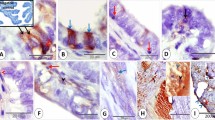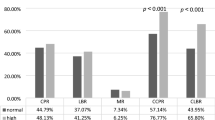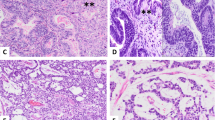Abstract
The presence of human chorionic gonadotropin in large bowel cancers was studied immunohistochemically using an immunoperoxidase technique. HCG-positive tumour cells were present in 42 of 194 adenocarcinomas examined (22.0% of colon cancer and 21.2% of rectal cancers). On histological grading, the hCG-positive rate tended to rise as the degree of differentiation decreased. HCG was detected more frequently in cancers invading the total bowel wall (27%) than in those invading the partial wall (17.1%). Lymph node, liver or peritoneal metastases were present more frequently in hCG-positive tumours than in hCG-negative tumours. Furthermore, there was an intimate correlation between the presence of hCG-positive tumour cells and CEA doubling times in nine cases with untreated liver metastasis. The survival rate for patients with tissue hCG-positive cells was lower than for those with hCG-negative tumours. Thus, the presence of tissue hCG in colorectal cancers may be a biological marker of prognostic significance.
This is a preview of subscription content, access via your institution
Access options
Subscribe to this journal
Receive 24 print issues and online access
$259.00 per year
only $10.79 per issue
Buy this article
- Purchase on Springer Link
- Instant access to full article PDF
Prices may be subject to local taxes which are calculated during checkout
Similar content being viewed by others
Author information
Authors and Affiliations
Rights and permissions
About this article
Cite this article
Yamaguchi, A., Ishida, T., Nishimura, G. et al. Human chorionic gonadotropin in colorectal cancer and its relationship to prognosis. Br J Cancer 60, 382–384 (1989). https://doi.org/10.1038/bjc.1989.289
Issue Date:
DOI: https://doi.org/10.1038/bjc.1989.289
This article is cited by
-
Identifying Appropriate Colorectal Cancer-Associated Antigens for the Clinical Trials
Current Colorectal Cancer Reports (2015)
-
Immunohistochemical expression of ?-human chorionic gonadotropin in colorectal carcinoma
Surgery Today (1996)



